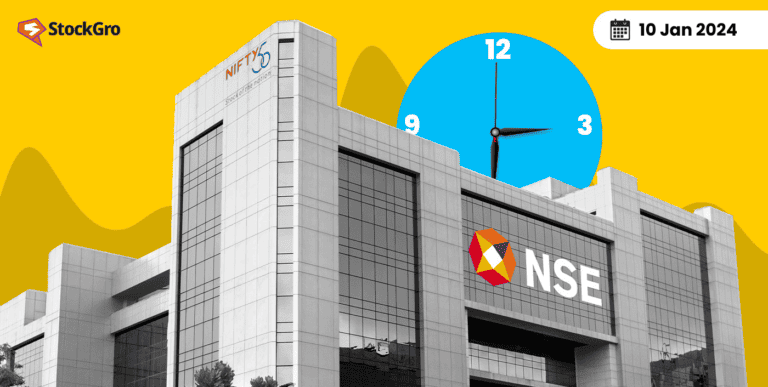Trading in the stock market requires a thorough analysis of stocks and the market as a whole. Traders use various tools in the process, both fundamental and technical. While fundamental tools help compare the stocks and choose the best one, technical tools help determine the profitable positions to enter and exit trades. One such technical tool is pivot points.
Today’s article discusses what pivot points are and how they help strategize intraday trades.
What is a pivot point in trading?
The pivot point is an indicator that determines market trends. It is usually calculated as an average of the previous trading day’s closing price, high price, and low price. Traders compare this value against the current day’s trading price to determine the market direction.
Generally, the stock price moving above the pivot point indicates a bullish market. The stock price stooping lower than the pivot point indicates a bearish market.
Pivot point trading strategy
Pivot point strategies are mainly helpful in intraday trades and other fast-moving trades. The strategy begins with locating five to seven points on a chart. While some traders stop at five points, others plot seven points for deeper strategies.
The first point is the fundamental pivot point and is located at the chart’s centre. It is the average of the previous trading day’s price points. Traders then locate two or three points above the primary pivot point, called resistance points 1,2 and 3. Similarly, they plot two or three points below the primary pivot point, called support points 1,2 and 3.
The stock price’s direction and crossing of these points suggest whether the stock is currently bullish or bearish.
Calculating pivot points:
P = (High + Low + Close) / 3
R1 = (P x 2) – Low
R2 = P + (High – Low)
S1 = (P x 2) – High
S2 = P – (High – Low)
Here, P is the pivot point, R1 is resistance level 1, R2 is resistance level 2, S1 is support level 1, and S2 is support level 2.
The formula to calculate pivot points can vary from one trader to another. The above is one variant and not a standard formula.
Besides the regular method of using pivot points, there are others, such as Fibonacci pivot points, Camarilla pivot points, Woodie pivot points, etc. Such methods recommend using advanced formulas to calculate pivot points while strategising intraday trades.
Pivot point breakout
The pivot point breakout strategy is a common strategy used by intraday traders, combining the concepts of breakout and stop-loss orders.
When the stock price breaks out from the resistance level, the stock represents a bullish trend, signalling the trader to enter a long position, i.e., to buy the stock. Similarly, when the stock price breaks and goes below the support level, it shows a bearish trend, indicating a sell or a short signal.
Setting a stop-loss level while following the breakout strategy helps to limit the loss. Generally, the stop-loss in a bullish trend is set below the breakout resistance point. The stop-loss in a bearish trend is set just above the breakout support point.
Also read: The ABCs of stock market: Consolidation and Breakouts
Pivot point bounce
A bounce in trading is when the stock’s price hits the support or resistance level and swiftly moves in the opposite direction from there. A breakout occurs when stocks move beyond the levels of support and resistance. Bounce, on the other hand, is when the stock touches the resistance level and steeply falls, or when it touches the support level and sharply rises.
In a pivot point strategy, a stock touching resistance and bouncing is a signal to sell. A stock touching the support level and bouncing upward is a signal to buy.
Bottomline
Intraday traders use pivot points trading as they are easy to understand. Since they use multiple price levels, the strategy provides good coverage. These price levels are also fixed throughout the day, making it simpler for traders to plan their trades.
However, it does not assure guaranteed movement of stocks. Like other technical indicators, pivot points can generate false alarms, too. All indicators work better when used in unison, rather than in isolation.
Also read: Relative strength index (RSI): A complete guide for traders
FAQs
Yes, the pivot point is a popular trading strategy. It is used by a large number of traders, especially in fast-moving markets like forex and intraday. The benefit of pivot point over other indicators is that it is simple to calculate and remains fixed, unlike moving averages which can be confusing.
Pivot points suggest the dominant trend in the market. They work better when used with indicators that suggest the strength of the trend, such as the Average Directional Index (ADX) and Relative Strength Index (RSI).
CPR in the stock market stands for Central Pivot Range. It is the primary pivot point that is calculated as an average of the previous day’s price points. The current price going above the CPR suggests a bullish trend, while the price going below the CPR suggests a bearish trend.
The primary disadvantage of pivot points is that they use historical data to compare it with current prices. It does not really help in forecasting future prices. The indicator helps identify the trend but does not guarantee that prices will move in the same direction.
Support and resistance show the minimum and maximum points that a stock’s price can reach. The general observation is that the stock prices reverse their trends upon reaching these points. Support and resistance points are used by a lot of traders to determine their entry and exit points.
